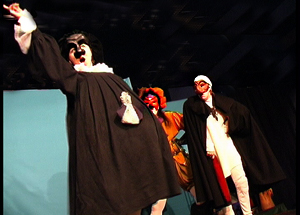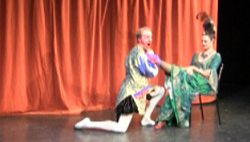If we go back to the heydays of Commedia dell’Arte the concept of canovaccio becomes more complicated. It was used both as a full scenario or just a plotline in a scenario. The word means “what’s on the canvas”. But I will use the word as I have learned it from Antonio Fava and then developed to my interpretation of the word, which I think is the most useful.
A canovaccio can be described as a simple plotline with a beginning, a development and an ending. It does not have more than one thread and it does not refer to anything outside itself. It is easy to see how the canovacci are related to the early ritual plays that were played during the rituals that formed Commedia dell’Arte. See HERE.
A canovaccio is one of the building blocks that make up a scenario. A scenario is built up from several canovacci. For example:
1, Arlecchino steals Brighella’s money and Brighella seeks revenge. Arlecchino dress up as a soldier to get away. Brighella who are now poor signs up in Arlecchino’s army. Arlecchino then force Brighella to do military drill and to always be faithful to the king, the fatherland and most of all Arlecchino.
2, Pantalone explains to his son, Flavio, that he is about to marry Dottore’s daughter, Silvia. Flavio protests because he wants to marry Silvia himself. Pantalone gets mad and sends away Flavio to the war to get rid of him. Flavio dress up as soldier. He gets instantly involved in a duel with another soldier who he thinks has abducted Silvia. It shows that the other soldier is Silvia who also has dressed up as a soldier. The both unmask themselves and decide to marry anyway.
3, Silvia who has been informed by her father, Dottore that her beloved Flavio are going to war and that she is espousal with Pantalone dress up as a soldier. She recruits a couple of soldiers and goes to attack Pantalone, who in turn is protected by Capitano’s army whish she defeats. Pantalone promises to have Flavio to come home and that he can marry who he will.
4, Capitano comes to a new town after just having lost a battle. Then Pantalone comes and hires him as a bravo. But Capitano gets into a fight and must flea the town.
Naturally a scenario can be more complicated with more canovacci interspersed. But we can see how each canovaccio have fairly simple plotline, that when it gets interspersed with other canovacci gets to be a quite complicated net of plotlines. It can also be much more tightly knitted than this example.
A canovaccio can also be played isolated. Something that can be very useful when playing in the streets where simplicity is much more demanded. To just play one canovaccio is also helpful since it keeps the plot simple and gives the cast the possibility to expand on the content such as the tricks and lazzi within the plot. When teaching using canovacci is unbeatable since we don’t have to worry about keeping a plot.
Back to Performance structure


